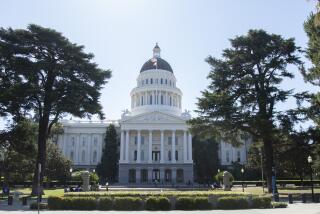Governors Work Out Deal on Education Reform : Politics: The compromise alters the panel that would grade the states and the federal government.
- Share via
MOBILE, Ala. — After a day of behind the scenes haggling over partisan differences, leaders of the National Governors’ Assn. on Sunday adopted a compromise plan for a commission that will grade the states--and the federal government--on progress toward education reform goals.
If the proposal is approved as expected by the full governors’ association on the last day of their annual meeting here Tuesday, the new agency, to be called the National Educational Goals Panel, will issue its first “report card” in September, 1991. This would mark the second anniversary of the education “summit” convened by President Bush in 1989 to help keep his promise that he would be “the education President.”
The seriousness of the disagreement over the shape of the commission was reflected by the fact that the governors’ task force on education was forced to call off a Sunday morning public meeting on the issue. Instead, members of the task force met privately, first by themselves and then with members of the governors’ association executive committee to hammer out the compromise that was approved by the executive committee at the close of the day’s business. Roger B. Porter, chief White House domestic policy adviser, was involved in the negotiations.
The compromise was designed to meet objections from Democratic governors and members of Congress that the structure of the assessment panel as initially envisaged by the governors’ task force would have allowed the Bush Administration to dominate the process to the disadvantage of Democrats.
Among the key changes which helped win Democratic support for the final version:
--Giving the governors six members on the panel, instead of four, with the chairman to be appointed annually by the head of the governors’ association. No more than three governors could be from the same party. Four other panel members would be appointed by the President. Four more would come from Congress, chosen on a bipartisan basis, and would serve only as non-voting members.
--In addition to grading the states on their progress, the panel would “report on the federal government’s action to fulfill those responsibilities set forth in the federal-state partnership.” This revision was intended to allay concern of Democrats that Bush would put the burden of progress toward reform on state governments, without providing adequate support at the federal level.
--Requiring a 75% majority for approval of all panel actions. This would forestall the four White House appointees from railroading decisions favorable to the Bush Administration through the panel.
The governors rejected a request from Democratic congressional leaders that the task of creating the panel be turned over to the House and Senate. “We felt strongly that since the states have responsibility for 90% of the funding for education nationally, they should have primacy in the assessment process,” said Republican Gov. Carroll A. Campbell Jr. of South Carolina, co-chairman of the education task force.
Among the major goals of reform, previously agreed to by the governors and the White House to be reached by the year 2000, are increasing the high school graduation rate to 90%, making U.S. students first in the world in math and science achievement, making every adult American literate, increasing learning readiness for preschoolers and freeing schools of drugs.
On another controversial area of federal-state relations, the federal budget deficit, White House Chief of Staff John H. Sununu failed to reassure the governors that the deficit negotiations between Congress and the White House would not have an unfavorable impact on the states’ own fiscal problems by shifting part of the deficit reduction burden to them.
While pointing out that Bush’s initial budget proposals this year concentrated on cuts in domestic federal spending programs which would not have hurt the states directly, Sununu contended that since the budget “summit” talks with the Democrats began, prospects had changed.
“We are in a negotiation process,” he said. “And certainly everybody within that summit can bring forward recommendations” for budget tightening measures.
Reflecting their concern with the consequences of federal budget policy, the governors’ executive committee adopted a resolution to establish a commission to “retain and restore the balance in the federal system” and to find ways to protect “state and local revenue bases.”
Before it was approved, this resolution was amended to include a proposal initiated by Democratic Gov. L. Douglas Wilder of Virginia dealing with the savings and loan scandal. The resolution urges Congress to create an independent commission to examine the causes of the problem and to find ways to “stop the drain on taxpayers’ money” and “provide for the equitable recovery of public monies expended in the bailout.”
More to Read
Get the L.A. Times Politics newsletter
Deeply reported insights into legislation, politics and policy from Sacramento, Washington and beyond. In your inbox twice per week.
You may occasionally receive promotional content from the Los Angeles Times.










